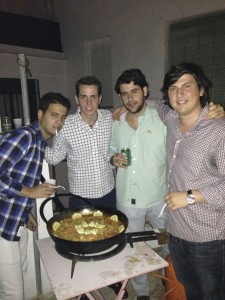Party N’ Paella
(Disclaimer: This post was written Friday, Jun 7th. Finding internet has been part of the journey.)
“Tapas on Tapas on Tapas.” That would be my answer for anyone asking what food I have been eating during my time here in Córdoba, Spain. Well that and “potatoes,” which have accompanied every lunch and dinner thus far. In the past six days, us students have tested out (and misinterpreted) many of the tapas dishes on menus at Loyola Andalucia and at the restaurants in the beautiful city around us. As I continuously order what I think is one plate and receive what turns out to be another, I slowly start to understand that, in España, Flamenquin is unrelated to Flamenco dancing and Tortillas are not used to create quesadillas. So far my list of favorites include a good Salmorejo (a tomato sauce with olive oil, garlic, bread, ham and egg), tortillas de camarones (a baby shrimp omelet), and Secreto Iberico (pork).
Dishes like these have provided half of the joy I’ve experience so far, but one meal that recently moved to the top of my favorites list is Paella. Paella is simply rice and seafood but its unique seasoning provides a rich flavor that lasts until the pot is empty. The dish takes hours to prepare, but when each flavor begins to mix and set in with another, it is impossible to pass up. I personally thought that I wouldn’t go near such a recipe with my dislike for onions and peppers, but it was definitely worth it. Just last night, the Loyola Chicago students studying abroad in Córdoba, local students helping with our assimilation, and other local friends we’ve made in the past few days gathered for a fiesta on the rooftop of the student apartments. On that night, we brought out the cerveza, opened the vino, and I made home made slushies with piña colada juice! We shared laughs, we shared at least a basic understanding of two languages, and we shared Paella. The picture above shows (from left to right) Antonio Torres, Rafa Cuesta, Jose Maria Martinez, and Carlos Fuentes-Guerra, who worked on this dish almost all night. When is was done, we grabbed forks and ate strait out of the pot until there were just bits of rice left. Talk about community bonding.
The food we had on that night was amazing, but it was especially important to me that I practice my spanish in all possible ways. It just so happens that today I’ll be practicing how to ask Carlos for the recipe so I can bring it home to my mother! Spanish dishes are definitely growing on me, but before I end, here are a few tips if you are ever ordering in spanish: “sangre” is very different from “sangria” and “huevos” are not the same as “huesos!”
Until next time, Adios!
-Lydia (or Lidia now that I’m in Spain ;])
